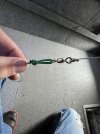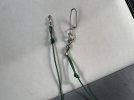Perhaps I didn't take time to explain the benefits as I'm a little confused by some questions so I will take a crack at explaining the benefits.
Firstly the material is thinner (less drag) than tuna cord. Secondly, the connection between your braid and the extension is a simple loop in your braid - there isn't a swivel...the only swivel is at the cannon ball end and that is to reduce line twist, but isn't necessary if you want to eliminate it. The blue material with the swivel is the replaceable line for attaching a scotty release clip (see pic) - serves to replace the standard prawn trap style attachment clips many people use - again less drag, cheaper, and a lot less fuss to do a quick change if the clip itself requires replacement. The only sharp edges are the quick connects for the scotty clip, but I haven't experienced any issues with those yet after 3 seasons on the water 90+ days each season.
The real benefit to using this system is its durability and the fact that it really resists breakage when dragged across the rocks, whereas tuna cord will very often break. I fish a lot of rocky structure close to the bottom, so occasional bottom contact is a fact of life. Since moving to this system I have virtually eliminated loss of cannon balls. If you do hook bottom, this system provides a little more time to stop, back up and get the ball off the bottom before things really go wrong. No it is not 100% fool-proof and I do lose some cannon balls. 2 lost last season and 0 the season before. Everyone will have a brain fart eventually, and really hang up...but in most situations you can stop, back up and get her back. That is where the cost savings comes in...cannon balls are way more $$ than this set up. You can ask my tackle supplier how many cannon balls I purchase now vs prior to using this system. No longer contributing to the kids college fund with cannon ball sales....I've advanced to buying fishing rods.
Pre-rigging - yup, I always have lots of replacements ready for quick change to eliminate time wasted during the bite. Better to prepare ahead of time, than scramble when the bite is on. All my pre-rigs have the scotty clip already attached so its just a matter of attaching a new cannon ball, and attaching the rigging to the braid and we are back in the saddle.
Hope this helps explain the benefits, just sharing in case its useful for someone else.




